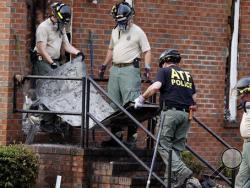GREELEYVILLE, S.C. (AP) — As investigators probe the cause of a fire that destroyed a rural South Carolina black church rebuilt after the Ku Klux Klan torched it 20 years ago, statistics show church fires are not unusual, and that the vast majority in recent years were not intentionally set.
Of the blazes that occurred at houses of worship dozens of times a week across the nation, about 84 percent were not intentionally set and many arsons are probably not hate crimes, the data shows.
Local and federal investigators said Wednesday that they haven't ruled out any potential cause for the fire at the Mount Zion African Methodist Episcopal Church. The fire happened late Tuesday as thunderstorms with frequent lightning rolled over Greeleyville, a small town about 50 miles north of Charleston.
But a federal official, who spoke on the condition of anonymity because he was not authorized to discuss the case publicly, told The Associated Press that preliminary indications show the fire was not the result of arson.
The fire was reported about 8:30 p.m. Tuesday and happened as federal authorities have been investigating a series of fires at black churches in several Southern states. So far, there is no indication the fires are related.
No one keeps an up-to-date tally of every church fire in the United States, making exact comparisons impossible.
Yet if the six church fires around the Southeast were all that occurred in recent days, it would prove a relatively safe period for houses of worship.
An average of roughly 31 congregations burned every week from 2007 through 2011, according to a 2013 estimate by the National Fire Protection Association. The association based its estimate on data collected by the U.S. Fire Administration and supplemented with survey results.
Arson was relatively rare. Just 16 percent of the blazes estimated at religious and funeral homes were intentionally set during the five-year period. That means arsonists set fire to roughly five religious structures every week. Those figures do not break out predominantly white congregations from black congregations.
Kitchen equipment and faulty heating or electrical systems were more likely to burn a church than an arsonist.
White supremacists in the South have burned black churches over the years as a political terrorism tactic. Coming after the slayings of nine people June 17 at a historic black church in Charleston, the recent fires attracted scrutiny from police and the general public.
"Perception matters," said Marty Ahrens, an analyst for the fire protection association. "We don't know all the causes of all the fires that have gone on this week. But if the church arsons had not happened so soon after the tragedy in Charleston, that horrible incident, would it have gotten the same level of attention?"
Some attacks on black congregations defy simple racial motives. For example, a taskforce formed by then-President Bill Clinton found that 63 percent of the people arrested for bombing or burning black churches in the late 1990s were white. But 37 percent were black.
The motives of the attackers varied widely, according to a taskforce report from 2000. Some suspects were vandals or pyromaniacs. Others were trying to cover up crimes such as burglary or financial theft. Others just held grudges.
The Rev. John Taylor, who is in his ninth year as the pastor of Mount Zion, said when he heard of the fire, he immediately recalled the blaze two decades ago.
"Of course we thought about it. We wouldn't be human if we didn't," he said Wednesday as he stood in the hot sun outside the charred shell of the church. But as to the cause of the most recent fire, he said, "I really thought it probably was a lightning strike."
On Wednesday, only the brick walls of the church remained, the narrow windows had no glass in them and a white cross on the front of the church appeared charred. Taylor said the church was a total loss, but that the congregation will rebuild. He said offers of help from across the country are already coming in.
Jesse Parker, the mayor of the community of about 400, said dealing with another church burning is a challenge but investigators will find out what happened.
"We'll just let them do their jobs and let them bring us the results of how it got started and we will accept the findings," he said.
___
Henry reported from Atlanta. Associated Press Writer Meg Kinnard in Columbia, South Carolina, contributed to this report.

